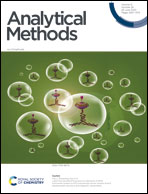The stabilization of fluorescent copper nanoclusters by dialdehyde cellulose and their use in mercury ion sensing†
Abstract
In the synthesis of metal nanoclusters (NCs), small molecules are widely used as capping ligands and reducing agents. However, metal NCs are usually sensitive to solvents and aerobic atmosphere and are also prone to oxidation; thus, their photonic properties deteriorate. In this work, 4-aminothiophenol (PATP) was used as a ligand to prepare Cu NCs and their fluorescence, morphology, and electronic states were characterized. The as-prepared Cu NCs could be dispersed in aqueous media and their fluorescence was sensitive to Hg2+. It was found that after mixing Cu NCs with 2,3-dialdehyde cellulose (DAC) prepared via oxidation by NaIO4, the fluorescence stability of Cu NCs could be enhanced from overnight to 7 days. This might be due to the reaction of the amine group of PATP with the aldehyde group of DAC to form Schiff bases, which are then reduced to form more stable C–N bonds via reduction by NaBH4. Therefore, Cu NCs were attached to a rigid skeleton and their stability increased. Furthermore, the composite of Cu NCs mixed with DAC could be used to prepare colorimetric cards for the rapid detection of Hg2+ with high sensitivity.



 Please wait while we load your content...
Please wait while we load your content...